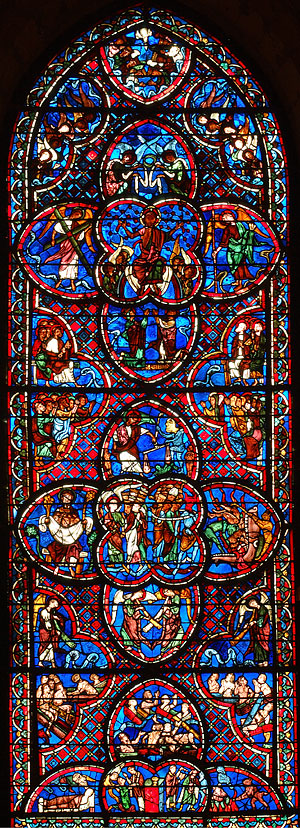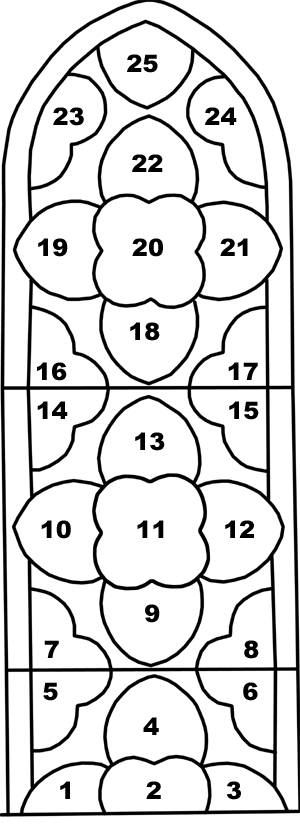Bay 4 - Key


Index to panels:
(Click
captions below to open detailed view in this window or click the relevant
panel on the diagrams to the left to open in a new window).
2) Good man and sinner in church
3) Sinner's soul tortured in hell
4) Dead
rising from their tombs
5) Dead rising from their tombs
6) Dead rising from their tombs
7) Angels
blowing trumpets
8) Angels blowing trumpets
9) Angels blowing trumpets
10) Souls of blessed in Abraham's bosom
11) Seperating the blessed and damned
12) The damned entering hell-mouth
14) Confessor saints
16) Apostles
19) Angel holding the True Cross
21) Angel holding lance and nails
22) Angel holding Crown of Thorns
23) Adoring
angels
24) Adoring angels
From the earliest days of figurative art in French churches, whether in portal sculpture, wall-painting or stained glass, the Last Judgement has always been one of the most important (and most frequently illustrated) themes.
Blah blah blah [a bit here about importance of LJ in glazing/decorative programmes in Gothic France - other prominent LJ ws of late 12th/early 13th C etc]
[bit about the artistic details - which workshop and defining features etc. bit about state of preservation, etc]
Depictions of the Last Judgement are naturally more declamatory than narrative. Indeed, since the event marks the end of time, it would be a little odd to expect much of a temporal element in the story (unlike the Apocalypse, which, albeit in visionary form, narrates the sequence of events that will precede the end of time). There is however a distinct structure which can be split into four main sections;
Panels 1-3; Unlike the rest of the window, these panels deal with the immediate or personal judgement that comes at each man's death. In panel 2, we see the good man receiving communion to the left and the sinner (dentifiable as a miser by the money bag around his neck) to the right being cast out of the church. Panels 1 and 3 show their subsequent fates. Although there is an implicit narrative progression from scenes 2(left) to 1 and from 2(right) to 3, the relationship is essantially causal rather than temporal. This triplet occupies the area usually reserved for donor scenes (i.e. depictions of the here and now) and thus serves as both a visual and an eschatological prologue for the rest of the action.
Panels 4-9; Here we see the bodily resurrection at the end of time, split between panels 4-6, with a variety of figures emerging intact from their graves in response to the angelic trumpets being blown in panels 7-9.
Panels 10-13; In panel 13, St Michael and Satan busy themselves with the weighing of souls. In the panel below we see the immediate consequence of this judicial proces - to the left, seven crowned male figures are led off to heaven by an angel, while to the right, a devil drags off the damned in chains. The fates of these two groups are then shown in the flanking panels - the blessed resting in Abraham's bosom and the damned pitched into Hellmouth.
Panels 14-25; The rest of the window is essentially a single composition, with the triumphant Christ, sitting as judge in the central pane (20), surrounded by the heavenly host - the various parts of the church triumphant below (14-17) and assorted angels, either paying homage or else presenting the Arma Christi (19, 21, 22). At the nexus between these panels and the previous group is the all important panel 18, where the kneeling figures of the Virgin Mary and John the Evangelist are shown interceding with Christ on behalf of the people below.
Grodecki Bay #: 11
Clement & Guitard p.16
Cahier & Martin vol.? p. ?
